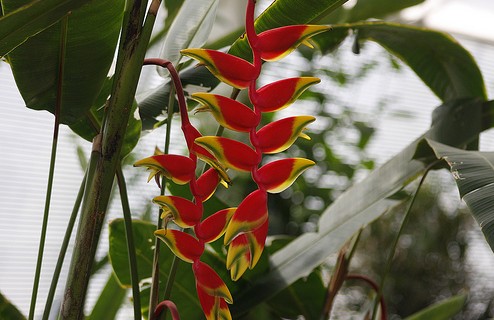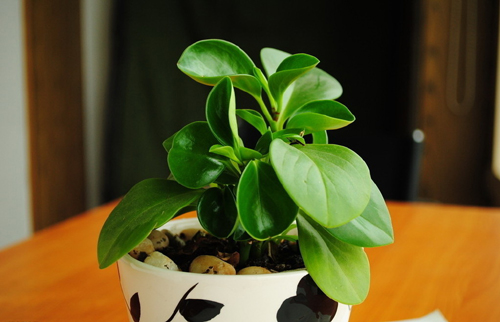How to cultivate weeping Firebird and Banana
Chuanhua Firebird banana is also known as Chuanhua Hejiao. The plant is tall and graceful, and the inflorescence is red and yellow. The leaves are like banana leaves, leathery. Spikes, "Zhi" shape drooping, inflorescence axis red, bracts are also red, the tip is golden yellow, 15 million 20, arranged in two rows, the shape is very similar to both beautiful birds, + points strange. The viewing period is as long as 3 months.
Hanging flowers, fire birds and bananas
Weeping Firebird Banana likes warm, humid and semi-shady environment, afraid of hot sun exposure, not cold-resistant, winter room temperature can not be lower than 12 degrees Celsius. It is suitable for sandy loam with deep, fertile and good drainage.
The plant shape of weeping Firebird banana is tall, and it needs enough water and fertilizer during the growth period. Usually apply one thin fertilizer every half a month, and apply phosphorus and potash fertilizer twice after pulling out the mullion. Pay attention to proper shading in summer so as not to burn the leaves. Cut off the withered leaves in winter and trim the plant shape properly in order to make the plant shape beautiful.
It is easy to be damaged by shell insects during indoor maintenance, so attention should be paid to timely prevention and control. If the maintenance and management is good, it can blossom continuously for more than 10 years. Ramet and sowing and propagation are commonly used.

Bonsai culture method of weeping Firebird and banana
Bonsai culture method of flaming birds and plantains with hanging flowers
Qianhua Firebird banana, also known as Chuanhua he banana, Xianhua scorpion tail banana, originated in Peru. Like high temperature and plenty of sunshine, the soil should be deep, fertile and slightly moist. Shade slightly in summer and pay attention to ventilation. The plant is tall and graceful, and the inflorescence is red and yellow. The leaves are like banana leaves, leathery. Spikes, "Zhi" shape drooping, inflorescence axis red, bracts are also red, tip is golden yellow, 15-20, arranged in two rows, the shape is very similar to a pair of beautiful birds, very strange. The viewing period is as long as 3 months.
Sexual like warm, humid and semi-overcast environment, afraid of hot sun exposure, not cold-resistant, winter room temperature can not be lower than 12 ℃. It is suitable for sandy loam with deep, fertile and good drainage.
The plant shape of weeping Firebird banana is tall, and it needs enough water and fertilizer during the growth period. Usually apply thin fertilizer every half a month, and apply phosphorus and potash fertilizer twice after pulling out the mullions. Pay attention to proper shading in summer so as not to burn the leaves. Cut off the withered leaves in winter and trim the plant shape properly in order to make the plant shape beautiful.
Cultivate and reproduce
Ramet and sowing were used to propagate. It is mainly ramet. It has strong dividing ability and rapid growth, so it is easy to cultivate offspring with ramet propagation. The ramet time usually takes place in spring. When ramets, dig up the seedlings from the ground, remove the mud, and then find out where the stems and roots are naturally separated. Cut the underground stem into several pieces with a hand or a sharp blade and plant it on a sandy loam rich in humus, loose and fertile, with a depth of 8~10cm. In the growing season, it is necessary to fully water and supply fertilizer, and apply liquid fertilizer rich in phosphorus and potassium once a month. Pay attention to shading when you just transplant, otherwise sunburn is easy to occur. For seed propagation, the germination temperature is 25-28 ℃, germinates about 20 days after sowing, and the seedlings blossom for 3-4 years.
It is easy to be damaged by shell insects during indoor maintenance, so attention should be paid to timely prevention and control. If the maintenance and management is good, it can blossom continuously for more than 10 years. Ramet and sowing and propagation are commonly used.
Loose and fertile loam is used in soil or potted plants. The growing period needs to be fully watered, fertilized once every semimonthly, and must not be dried at low temperature. The summer flowering period should be shaded properly and the phosphorus and potassium fertilizer should be applied twice. Cut off the dead leaves in winter and keep the plant shape beautiful. The overwintering temperature is above 12 ℃. Plantlet planting can bloom in the second year, good cultivation management, and can blossom continuously for more than 10 years. There are many kinds of horticulture, such as safflower, orange blossom, pink blossom and so on.
Diseases and insect pests
The main diseases and insect pests are powdery mildew, black spot and so on. Generally, when the disease occurs on the inflorescence, the stone-sulfur mixture of 0.3% to 0.5% Baume can be sprayed to kill the disease, or 50% carbendazim 800 times dilution. Common insect pests include aphids, ants and so on. The control of aphids can be sprayed with carbendazim, etc. Ant control is sprayed with 50% omethoate emulsion 800-1200 times or 80% dichlorvos EC 1000 times.
Indoor potted plants, such as poor ventilation, prone to shell insects, can be sprayed with 1000 times of imidophos EC.
Culture and management of weeping Firebird and banana
Heliconia rostrata Ruiz generally refers to the golden-billed scorpion tail banana, golden-billed scorpion tail banana (Pavon): Banana family, scorpion tail banana is a perennial herb. The height of the plant can reach 6 meters. Leaves oblong, green, bright purple on back; terminal inflorescence, erect, thinly pubescent; bracts green, protruding when open, perianth red, apical green, narrowly Terete, fruit trigonous, grayish blue, with no more than 3 seeds. It blossoms from May to October.
[culture method] sowing or ramet culture in early spring. The ramets were cut and planted when the lateral branches next to the mother plant sprouted in early spring. Pay attention to shading when you just transplant, otherwise sunburn is easy to occur. Soon, the new erect stem grows from the top of the lateral underground stem. For seed culture, the germination temperature is 25-28 ℃, germinates about 20 days after sowing, and the seedlings bloom for 3-4 years. [cultivation management] like high temperature and sufficient sunshine, and the soil should be deep, fertile and slightly moist. Shade slightly in summer and pay attention to ventilation. Can be potted, more suitable to plant. Loose and fertile loam is used in soil or potted plants. Potted plants can be cultivated in large pots with rotten leaf soil or peat soil. When the twig grows to 20~25cm, the management of water and fertilizer should be strengthened, enough water should be kept, and enough light should be given. Fertilize every semimonthly during the growing period, do not dry at low temperature. After the inflorescence is extracted, the proportion of phosphorus and potassium fertilizer should be increased to make the flower color more beautiful. Flowering mainly depends on the plant age. Generally, plants germinated before the beginning of April are expected to bloom in the following year. If they germinate after the end of April, they will not blossom until the third year. The remaining branches and leaves should be cut off in winter to keep the plant shape beautiful. If properly managed, there are many spikes and blossoms in summer, and each inflorescence blossoms one flower in 3 days, and the whole viewing period can be as long as 4 Murray for 5 months. The overwintering temperature is above 12 ℃. This species has extensive growth, strong resistance and few diseases and insect pests. Indoor potted plants, such as poor ventilation, prone to shell insects, can be sprayed with 1000 times of imidophos EC.
- Prev

How to cultivate Zibian Jasper
Purple edge Jasper, also known as pepper grass, Piperaceae grass pepper, perennial herbs. Native to the West Indies, Panama, northern South America. Like the warm and humid semi-overcast environment. The suitable temperature for growth is about 25 degrees Celsius, the lowest can not be lower than 10 degrees Celsius, it is not resistant to high temperature, requires high air humidity, and avoid direct sunlight.
- Next

Shallow planting water wax bonsai
Water wax belongs to the water wax family, evergreen all the year round, resistant to pruning, easy to shape, is an excellent material for making bonsai. This water wax tree stump oblique trunk tree stump height of about 60 cm, from the basic part of the two roots trend is very good, the overall transition is also good, after analysis and thinking, it is concluded that this is a very good bonsai creation material, natural and generous, very lasting. In order to ensure the survival of the shallow planting, I successfully transplanted the pile into the shallow basin by using the three-step method. The specific method is as follows: in the first step of ①, I prepared a medium earthen pot to plant water wax stakes, and at the same time used loose ones.
Related
- Fuxing push coffee new agricultural production and marketing class: lack of small-scale processing plants
- Jujube rice field leisure farm deep ploughing Yilan for five years to create a space for organic food and play
- Nongyu Farm-A trial of organic papaya for brave women with advanced technology
- Four points for attention in the prevention and control of diseases and insect pests of edible fungi
- How to add nutrient solution to Edible Fungi
- Is there any good way to control edible fungus mites?
- Open Inoculation Technology of Edible Fungi
- Is there any clever way to use fertilizer for edible fungus in winter?
- What agents are used to kill the pathogens of edible fungi in the mushroom shed?
- Rapid drying of Edible Fungi

